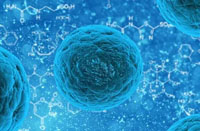Dr. Rongxiang Xu Invents "Potential Regenerative Cell" and Wins a Patent after 11 years’ Debate.
Dr. Rongxiang Xu published the discovery of Potential Regenerative Cells (PRCs) in 2002, ever since then, it has been receiving controversial comments, and Dr. Xu was regarded as the most controversial scientist by media. Zhouzi Fang, a Chinese science writer and fraud fighter, once published a paper stating that “Dr. Xu is mixing false with genuine”. Lately, State Intellectual Property Office of P.R.China (SIPO) has officially granted Dr. Xu Rongxiang a patent for the invention of PRCs, This news once again hurls Dr. Xu into the limelight.

Recently, SIPO of P.R. China officially granted Dr. Xu Rongxiang a patent for the invention of PRCs. The discovery and invention of PRCs means the affirmation of the existence of the innate human regenerative potential, means that human will have regenerated life that is new to all human. For this reason, ever since the publication of PRCs in 2002, it has received controversial comments, and even Dr. Xu was considered the most controversial scientist by the media. With the recognition of PRCs from Chinese SIPO, the 11 years’ debate over the PRCs finally comes to an end.
Dr. Xu has been Granted US Patents
In December 2006, when the science world was caught up in the ethical issues of embryonic stem cell, Xu and his research team finished the regeneration of tissue organs from somatic cells in vivo and in vitro, achieved in situ regeneration of skin organ, gastrointestinal organ and other functional tissue organs, and realized the physiological restoration (including functions) of damaged organs. The success of this technology has earned Dr. Xu multiple patents in US.
The technology of regeneration of tissue organ from somatic cells has been granted a patent, this does not only suggests the leading role of the technology in Chinese life research, but also means 21 years intellectual protection, most importantly, this patented technology opens a new research area in life science, greatly advanced the research in life science, cell science and medical science, and is an amazing blessing to human life.
Nowadays, people have been expecting to clone tissues and organs from stem cells, and then transplant the cloned organs to the damaged area for treatment. Stem cell can only be obtained from human embryo. The harvest of stem cell from embryo would cause damage to the embryonic life and breach human ethics, thus this idea has been put to an end. In contrast, Dr. Xu transforms human somatic cells into stem cell like cells, realizes tissue clone in situ, and achieves human organ restoration and regeneration in situ. In this sense, this patented technology of cloning organ from somatic cells is far better than the stem cell therapy idea. This is not only a new research area in life science, a new technology to prevent and treat human organ damage, but also the new hope for long and healthy life.
Dr. Xu Rongxiang lodged a protest against the infringement by some American and Japanese Scientists.
From November 19th to 20th, 2007, some American and Japanese Scientists published related research on two leading science journals separately, and they declared that they have successfully induced human skin cells into embryonic stem cell like cells. However, their reports failed to give references or mention anything about quoting Dr. Xu Rongxiang’ s long published work of inducing somatic cells into tissue stem cells and realizing organ clone. “This is not fair, it is bullying”, Dr. Xu Rongxiang was quite upset about this disrespectful behavior.
Dr. Xu said to the media, science has no nationality, but science respects facts, and the fact is the research findings about inducing somatic cells into stem cells (though with different method) published by the American and Japanese scientists has long been propounded by Dr. Xu Rongxiang. Dr. Xu thinks the findings of the American and Japanese scientists were based on his research concept, “it is obviously a violation of my right of fame, scientific fact and scientific norms, and the taboo in science world”.
Therefore, Dr. Xu issued a statement to set the record straight. The statement went as the following, “recently, many mainstream media in US and Japan reported the induced Pluripotent Stem Cell as a milestone in life science. As a human, I am happy for this, I also praise the idea of using virus to induce somatic cells into stem cells. However, I am outraged when they failed to give reference to my research concept that has been published in China long ago and when the fame and right of China’s contribution to human were violated. Early in 2002, I published the research findings of inducing somatic cells into pluripotent stem cells, applied and obtained patents in many countries including US, which is a well-known fact to the scientific world. The behaviors of these American and Japanese scientists neglected the Chinese scientific achievement by claiming to represent the milestone of life science. This is a violation of scientific norm and a misguidance to media.”
Dr. Xu Rongxiang is Granted Patent for the Invention of “Potential Regenerative Cells”
Human body develops from zygote and embryo, and is consisted of 60 trillion somatic cells; these cells can renew 50 – 60 times before completing their life journey. In the research of in-situ skin organ regeneration for deep burn cases, Dr. Xu discovered a group of cells in human organ tissues that have the regenerative potential. Like the other types of cells, these “Potential Regenerative Cells (PRCs)” exist in organ tissues. Once the cells in the organ die or lose function, the potential regenerative cells will come into play, turn into pluripotent stem cells, regenerate new cells, tissues and tissue organs in situ, and restore the structure and functions of the organs. In vitro culture of the PRCs can also turn into stem cells and regenerate new tissues and tissue organs. PRC is a great invention in human life science history, and will bring new regenerative life to human.
In 2002, Dr. Xu Rongxiang reported publicly the discovery of “PRCs”, which was considered an explosion to human life science by the media. The report received all kinds of controversial comments in the science world, because it was never mentioned in any of the textbooks, common sense or researches, it was a new concept to the world, a new word, new function and method, and hence, it was reasonable to receive controversial comments. At that time, Ministry of Science and Technology of People’ s Republic of China organized a state-level public hearing, which enjoyed the attendance of 15 academicians and professors. The hearing didn’t deny PRCs, thus never stopped the controversy. The State Intellectual Property Office of P.R.China carried out careful review about PRCs, from acknowledgement to deny then back to acknowledgement, and after 11 years’ review and appraisal, the SIPO finally and officially granted Dr. Xu Rongxiang a patent for the invention of PRCs.
With regard to the advance of world life science, Dr. Xu Rongxiang pointed out that the frontiers of world life science usually refers to genome research, embryonic stem cells research, organ regeneration from somatic cells, and human tissue engineering. Since the discovery of DNA double helix in mid 20th century, people have been hoping to treat disease with gene therapy. However, on March 21, 2013, the father of gene therapy, Professor Watson deprecate this therapy; he said that sequencing genes isn't proving to be particularly useful in fighting such diseases as cancer and that much of the research being done on the subject is irrelevant. Dr. Xu said: “I am proud to tell all my fellow Chinese, the only frontier science that has realized clinical application is the in-situ regeneration and restoration of human organ through PRCs, and this has been incorporated into National Development Policy of United States of America by President Obama.”








